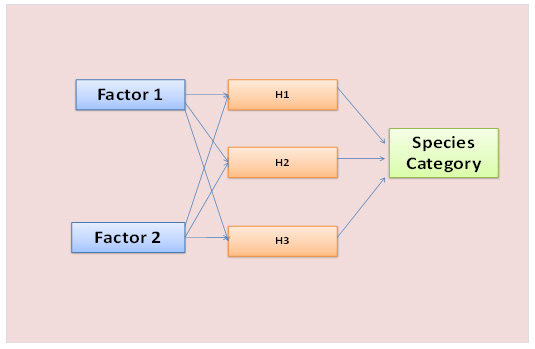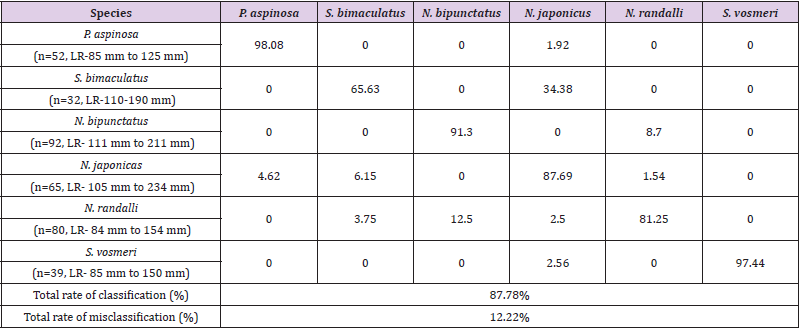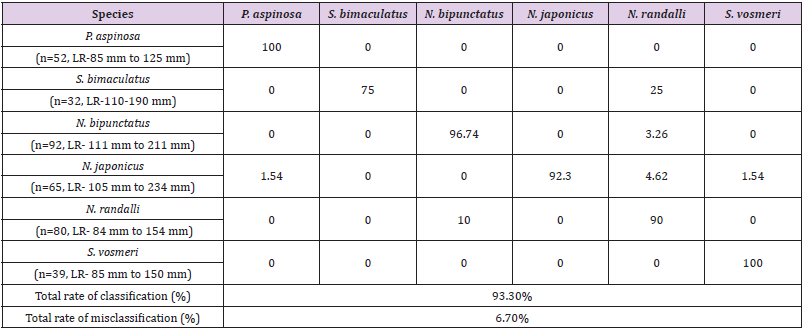ABSTRACT
Present study was carried out to identify six important species (Nemipterus japonicus, N. randalli, N. bipunctatus, Scolopsis vosmeri, S. bimaculatus and Parascolopsis aspinosa) under the family Nemipteridae based on their morphometric characters. A total of 360 samples were collected randomly from east and west coast of India. Twenty one morphometric distances, measured from each individual, were subjected to factor analysis where body depth and fin base measurements explained 53% variations while head related measurements explained 20% of the variations among the six species. Artificial neural network analysis and discriminant function analysis was able to classify, 87.8% and 93.3% of the samples, correctly to the respective species. Results underlined the utility of the morphometric characters as a basis of fish identification when there is an overlap of characters among the species.
Keywords: Nemipteridae; Species; Morphometric Character; Factor Analysis; Discriminant Function Analysis
Introduction
Many authors have described external morphology as an integral part of ichthyology of many fishes Hubbs and Lagler [1- 5]. External features are used in species differentiation ever since ichthyology can be traced back Strauss and Bond [6]. Morphometry is reliable in case of aged specimen also because long term preservation leads to loss of weight but limited effects on length measurements Shields and Carlson [7]. Nemipterids are one of the most economically important fish groups of tropical Indo- West pacific and taxonomically difficult group to distinguish them Russell [8]. Nemipterids of Indian waters are limited to three genera namely Nemipterus, Scolopsis & Parascolopsis Barman and Mishra [9]. Fishes from family Nemipteriidae contribute significantly towards Indian marine fisheries, with a share of 5.3% towards total marine fish production and 18.9% of demersal fish production CMFRI [10]. Nevertheless, in view of importance of nemiptreids the present communication is an attempt to distinguish the species of family Nemiteridae from Indian waters.
Material and Methods
Sampling
Samples of six species of the family Nemipteridae (Nemipterus japonicus, N. randalli, N. bipunctatus, Scolopsis vosmeri, and Parascolopsis aspinosa) were collected from Versova fish landing centre, Mumbai and also from the trawl catch of research vessel ‘MFV Narmada’ of Central Institute of Fisheries Education. Specimens of S. bimaculatus were collected from Pamban landing centre of Mandapam, Tamil Nadu. A total of 360 fish samples weight were collected randomly between October 2010 and December 2010 (Table 1).
Morphometric Measurements
Digital images can be used for measuring the morphometric variables along the surface of the fish after transforming them into readable formats on computer Sajina, et al. [11]. Hence the image of each fish specimen was first captured using a cyber-shot DCS-S500 digital camera (Sony, Japan). Twenty one morphometric distances were measured along the entire body surface on left side of the fish i.e., head, trunk and tail. These distances were measured using the software “tpsdig2 V2.17” Rohlf [12].
Transformation for Removing Size Dependent Effects
The size dependent variation in the whole data may discriminate the population based on size Humphries, et al. [13]. Significant correlations were observed between body size and the morphometric variables. Therefore, the absolute morphometric variables were transformed into size independent shape variables. The distances measured were first tested for outliers and they were removed based on Cook’s distance estimates using PROC ROBUSTREG procedure of SAS, as they may distort the general tendency in the size distribution SAS Institute [14]. Further the size dependent effects were removed using an allometric approach by Reist [15]. Data were transformed using the formula:

Where,
Y’ij : Transformed morphometric measurement
Yij : Original morphometric measurement
SLi : Standard length of the fish
: Overall mean standard length of the fish
bj : Regression coefficient of the log Yij on loglogSLi.
Multivariate Analysis
The multinomial test, Mardia’s test was used to check whether the data follows a multivariate normal distribution Cox and Small [16]. This was done by using PROC MODEL procedure on the transformed morphometric measurements in SAS SAS Institute [14]. Factor analysis is a statistical method used to describe variability among observed, correlated variables in terms of potentially lower number of unobserved variables named factors. For example, it is possible that variations in four observed variables can reflect the variations in two unobserved variables. Factor analysis searches for such joint variations in response to unobserved latent variables. Observed variables are modeled as linear combinations of the potential factors, plus “error” terms. The information gained about the interdependencies between observed variables can be used later to reduce the set of variables in a dataset. Computationally this technique is equivalent to low rank approximation of the matrix of observed variables.
In the present study, twenty one morphometric measurements were subjected to factor analysis by using PROC FACTOR procedure of SAS (SAS Institute, 2010), to test whether morphometric characters are effective in discriminating the species. In the factor analysis, the transformed morphometric distances which loaded high on the first and second factors were identified. Variables loaded on different factors were selected based on the Hatcher’s scratching procedure Hatcher [17], and Artificial Neural Network (ANN) analysis was employed by NEURAL MODEL option in JMP 8 (SAS Institute, 2010) to find out the accuracy of classifications of observations among different species on the basis of the first two factor scores. ANN is a nonlinear mathematical structure capable of representing complex nonlinear process that relates the inputs to the outputs of a system Pulido - Calvo and Portela [18]. The structure of a neural net consists of connected units referred to as “nodes” or “neurons”. Each neuron performs a portion of the computations inside the net. A neuron takes some numbers as inputs, performs a relatively simple computation on these inputs, and returns as an output. Output value of a neuron is passed on as one of the inputs for another neuron, except for neurons that generate the final output values of the entire system.
In the present study, we used a single layered feed forward network (SLFN) of 3 hidden nodes with the following specifications (Figure 1).
1. Input layer: the scores of first and second factors
2. Hidden layer: 3 hidden nodes; H1, H2 and H3
3. Output: species category
4. Over all penalty =0.01
5. Number of tours = 4
6. Iterations = 500
7. Training data set = 65% of the observations
8. Cross validation = Random Hold back
Figure 1: Single layered feed forward artificial neural network with 3 hidden nodes (H1, H2 and H3).
For a set of observations containing more than one quantitative variables and a classification variable defining groups of observations, the discriminant function analysis can develop a discriminant criterion to classify each specimen into one of the groups which can be locations or coasts based on the context of analysis Rao [19].
Results
The factor analysis revealed that there is a significant morphometric variation between the species. The variables with high loadings on the first two factors were found useful in distinguishing these species.
Differentiation of Different Species Under Nemipteridae Collected Along Indian Coasts
The plot between first and second factor scores indicates the morphometric discrimination of different species (Figure 2). The measurements loaded on the first factor were associated to vertical body depth and fin base measurements. The distances; body depth, dorsal fin base length, pectoral fin base length, caudal fin base length, caudal peduncle depth and second anal fin length were found to have significant loadings on the first factor which explained 53% of the total variation. The second factor represented the measurements associated with the head like eye diameter, head length, pre pelvic fin length and pre pectoral fin length. The analysis revealed a larger dimension of body depth and fin base measurements in S. vosmeri and a larger proportion of head measurements in P. aspinosa.
Classification by Discriminant Function Analysis
The first and second factor scores obtained in the factor analysis were taken for classifying samples among different species. Species wise discriminant function analysis has given 87.78% of accuracy in classifying the observations to various species (Table 1). The results of analysis indicate clear discrimination of the samples among different species.
Table 1: Cross-validation of individuals classified by discriminant analysis. Percentage of each species classified by discriminant analysis to their respective species (in columns).`n’ and ‘LR’ indicate the total number of samples and their length ranges for respective species.
Classification by Artificial Neural Network
The first two factor scores were taken for classifying samples among different species. Species wise neural network analysis of one hidden layer with three hidden nodes was carried out with the selected variables as the input and species category as the output. As a training data, 65% of the observations were fed to the network and the remaining data set was kept for validation. The results of this analysis have clearly discriminated the samples among different species with 93.3% of accuracy in classifying the observations to various species (Table 2).
Table 2: Random Hold back cross-validation of individuals classified in ANN analysis. Percentage of each species classified by ANN analysis to their respective species (in columns). ‘n’ and ‘LR’ indicate the total number of samples and their length ranges for respective species.
Discussion
The methods employed (factor analysis, discriminant function analysis and artificial neural network) have effectively proved that morphometrics alone is accountable for discriminating fish species. Body depth and fin measurements are loaded on first factor shows swimming is attributed in the variation primarily, whereas second factor loaded with head length and head associated measurements (eye diameter, pre pelvic fin length, pre pectoral fin length). Genus Scolopsis and Parascolopsis were notably varied based on the body depth and head measurements, respectively, as they were slow swimming and exclusively inhabit coral reefs Aleyev [20,21]. N. japonicas, N. bipunctatus and N. randalli being fast swimmers, has thin caudal peduncle depth compared to Scolopsis and Parascolopsis because thin caudal peduncle aids in fast swimming Assumpcao, et al. [22]. Fishes belonging to the genus Scolopsis and Parascolopsis were having deep body than fishes of genus Nemipterus. Being a benthic species of inshore waters inhabiting usually on sand or mud bottoms close to reefs, S. vosmeri, S. bimaculatus and Parascolopsis aspinosa possess more deep body than other fishes. Deeper and shorter caudal peduncle are characteristics of fast swimming fishes Gatz [23], and an increased body depth may also impart the same Watson and Balon [24]. The robust peduncle of deep water fishes may allow burst swimming as a part of successful ambush behavior needed for more mobile prey Bronte, et al. [25]. Multivariate analysis of morphological measurement in fishes is useful method to support inference of patterns of interspecific ecological diversification Winemiller & Taylor [26,27]. Discriminant function analysis found to be a successful to discriminate among species. Turan, et al. [28] were able to classify overall 78% among six populations of Clarias gariepinus. Similarly, Pollar, et al. [29] classified 95.6% for Tor tambroides. Artificial Neural Networks has proven fit for identification of fish schools based on acoustic data Haralabous and Georgakarakos [30] and later applied in species identification based on acoustic data Cabreira, et al. [31]. Morphometric measurements are another input for species identification Morimoto, et al. [32,33].
Acknowledgement
The study was conducted at Central Institute of Fisheries Education (CIFE, Indian Council of Agricultural Research), India. We are thankful to Dr. W.S. Lakra, Director, ICAR-CIFE for providing financial and technical support to conduct the study. We are also thankful to ICAR-Central Marine Fisheries Research Institute for all the help in sample collection.
References
- Hubbs CL, Lagler KL (1958) Fishes of the Great Lakes Region, (2nd)., Cranbrook Institute of Science Bulletin 26: 1-213.
- Miller DJ, Lea RN (1972) Guide to the costal marine fishes of California. California Department of Fish and Game, Fish Bulletin, p. 157.
- Lagler KF, Bardach JE, Miller RR, Passino DRM (1977) Ichthyology, John Wiley & Sons, New York, p. 528.
- Bond CE (1979) Biology of Fishes. WB Saunders, Philadelphia.
- Moyle PB, Cech JJ Jr (1981) Fishes: an introduction to ichthyology. Prentice-Hall, Englewood Cliffs, New Jersey, pp. 744.
- Strauss RE, Bond CE (1990) Taxonomic methods: morphology. In: Schreck CB, Moyle PB, (Eds.)., Methods for fish biology: Bethesda, M.D: American Fisheries Society, pp. 109-140.
- Shields PA, Carlson SR (1996) Effects of Formalin and Alcohol Preservation on Lengths and Weights of Juvenile Sockeye Salmon. Alaska Fishery Research Bulletin 3(2): 81-93.
- Russell BC (1990) FAO species catalogue. Nemipterid Fishes of the World. Family Nemipteridae. An Annotated and Illustrated Catalogue of Nemipterid Species known to Date. FAO Fisheries Synopsis. No. 125(12): 149.
- Barman RP, Mishra SS (2009) A Pictorial Guide To The Fishes of the Family Nemipteridae of India. P. 50. Zoological Society of India.
- (2013) CMFRI. Annual Report 2012-13. Central Marine Fisheries Research Institute, Cochin, pp. 200.
- Sajina AM, Chakraborty SK, Jaiswar AK, Pazhayamadam DG, Deepa Sudheesan (2010) Stock structure analysis of Megalaspis cordyla (Linnaeus, 1758) along the Indian coast based on truss network analysis. Fisheries Research 108(1): 100-105.
- Rohlf FJ (2004) tpsDig, digitize landmarks and outlines, version 2.0. Department of Ecology and Evolution, State University of New York at Stony Brook.
- Humphries JM, Bookstein FL, Chernoff B, Smith GR, Elder RL, et al. (1981) Multivariate discrimination by shape in relation to size, ibid. 30(3): 291-308.
- (2012) SAS Institute Inc. SAS®3. Cary, NC: SAS Institute Inc.
- Reist JD (1985) An empirical evaluation of several univariate methods that adjust for size variation in morphometric variation. Can J Zool 63(6): 1429-1439.
- Cox DR, Small NHJ (1978) Testing multivariate normality. Biometrica 65: 263-272.
- Hatcher L (2003) A step by step approach to using SAS for analysis and structural equational modelling. Cary, NC: SAS Institute Inc, pp. 588.
- Pulido-Calvo I, Portela MM (2007) Applications of neural approaches to one step daily flow forecasting in Portuguese watersheds. Journal of Hydrology 332(1-2): 1-15.
- Rao M (1973) Abstract Martingales and Ergodic Theory. In: Multivariate Analysis III. (Proc. Third Internat. Sympos., Wright State Univ., Dayton, Ohio, 1972, p. 45-60.
- Aleyev YG (1963) Functional Principles of External Structure of Fish. Moscow: Nauka Press (in Russian).
- Smirnov VV, Shumilov ID (1974) Omuls of Baikal. Novosibirsk: Nauka Press (in Russian).
- Assumpcao LD, Makrakis MC, Makrakis S, Wagner RL, Silva PSD, et al. (2012) The use of morphometric analysis to predict the swimming efficiency of two Neotropical long-distance migratory species in fish passage. Neotropical Ichthyology 10(4): 797-804.
- Gatz AJ Jr (1981) Morphologically inferred niche differentiation in stream fishes. American Midland Naturalist 106: 10-21.
- Watson DJ, Balon E (1984) Ecomorphological analysis of taxocenes in rainforest streams of northern Borneo. J Fish Biol 25(3): 371-384.
- Bronte CR, Fleischer GW, Maistrenko SG, Pronin NM (1999) Stock structure of Lake Baikal Omul as determined by whole body morphology. J Fish Biol 54: 787-798.
- Winemiller KO, Taylor DH (1987) Predatory behaviour and competition between smallmouth and largemouth bass. American Midland Naturalist 117(1): 148-166.
- Winemiller KO (1991) Ecomorphological diversification in lowland freshwater fish assemblages from five biotic regions. Ecol Monogr 61(4): 343-365.
- Turan C, Yalcin S, Turan F, Okur E, Akyurt I (2005) Morphometric comparisons of African catfish, Clarias gariepinus, populations in Turkey. Folia Zool 54(1-2): 165-172.
- Pollar M, Jaroensutasinee M, Jaroensutasinee K (2007) Morphometric analysis of Tor tambroides by stepwise discriminant and neural network analysis. World Academy of Science, Engineering and Technology 33: 16-20.
- Haralabous J, Georgakarakos S (1996) Artificial neural networks as a tool for species identification of fish schools. ICES Journal of Marine Science 53(2): 173-180.
- Cabreira AG, Tripode M, Madirolas A (2009) Artificial neural networks for fish-species identification. ICES Journal of Marine Science 66: 1119-1129.
- Morimoto E, Taira Y, Nakamura M (2009) Identification of Fish Species using Neural Networks. Journal of National Fisheries University 58(1): 65-71.
- Wilson EO (2004) Taxonomy as a fundamental discipline. Phil. Trans. Royal Soc. Lond B Biol Sci 359(1444): 739.

 Research Article
Research Article



